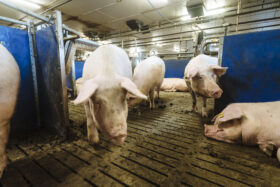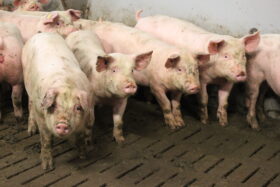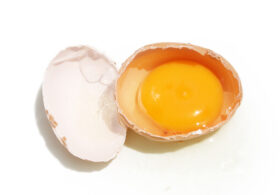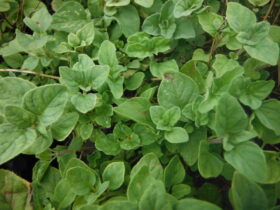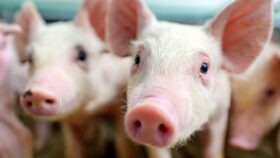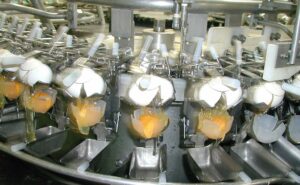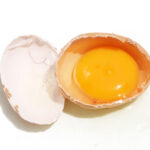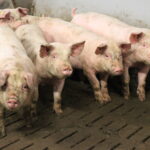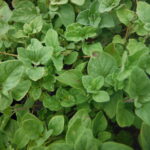Conference Report
Heat stress poses a significant challenge to pig production, particularly in Asia, due to the region’s warm and humid climate. In the following, Dr. Merideth Parke, Global Application Manager Swine at EW Nutrition, discusses effective management strategies to mitigate the adverse effects of heat stress on pig health and productivity.
Understanding Heat Stress
Pigs are particularly vulnerable to heat stress due to their limited ability to dissipate heat. “This is because they lack functional sweat glands, have relatively small lungs, a thick subcutaneous fat layer, and a narrow thermoneutral zone. The pigs’ thermoneutral or ‘comfort’ zone varies by age and weight. For instance, sows require 18-22°C, grow-finish pigs less than 25°C, while newborn piglets need a much warmer 35°C,” she explained.
Furthermore, today’s lean and efficient pigs have higher metabolic demands and produce more body heat, making them more susceptible to heat stress than pigs from the 1980s.
Symptoms of heat stress include:
- Increased respiration rates (>50/minute)
- Elevated rectal temperature (>39.5 oC)
- Decreased feed intake
- Reduced growth rates
- Lower reproductive performance
- Lower reproductive performance
Pigs naturally reduce their feed intake as a response to heat stress, which is a mechanism to decrease metabolic heat production from digestion. For example, research on sows has shown that for each 10°C increase between 25-27°C at 50-60% relative humidity, they reduce their feed intake by 214 g/day.
Managing Heat Stress
Managing heat stress is complex. It requires a combination of solutions specific to each production system. Additionally, it must be considered that heat stress is not only about temperature. Its impact can be exacerbated by relative humidity, which hinders heat dissipation through evaporation. The heat index chart below demonstrates the relationship between temperature, humidity, and comfort levels for a grow-finish pig. Pigs require an environment where the heat index is within the thermoneutral zone, enabling them to shed heat and maintain efficient feed utilization and growth.
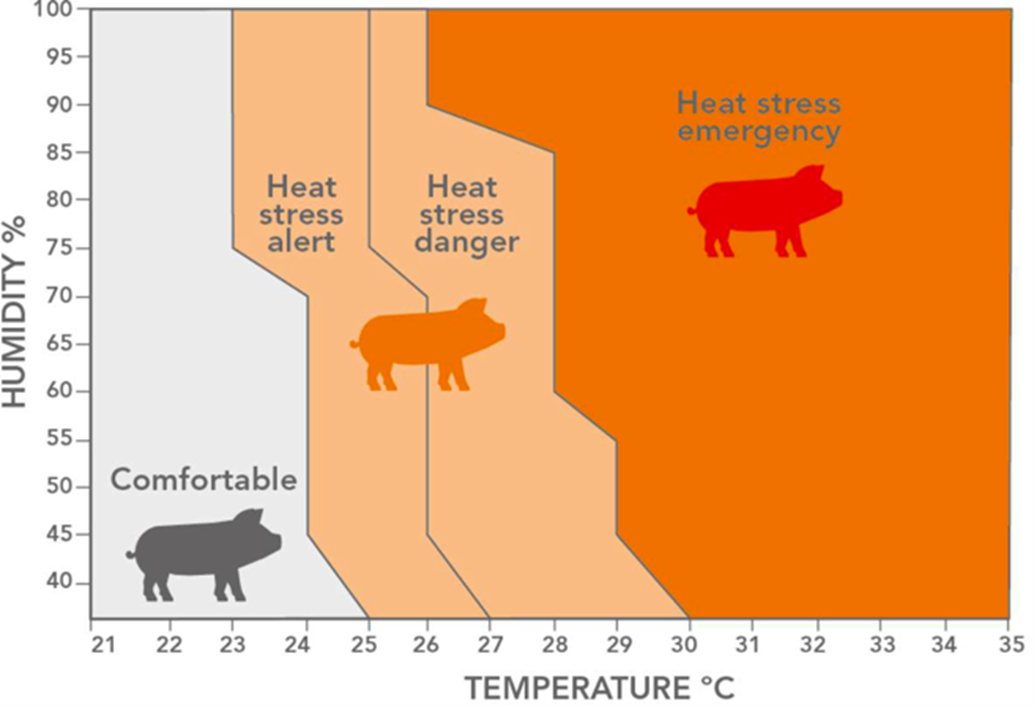
While we often initially look to nutritional interventions, such as reducing dietary crude protein levels, increasing fats, or adding feed additives such as betaine, the effectiveness of these heat mitigation strategies is limited if the pigs are not eating well. Therefore, we must first focus on environmental management to reduce external heat absorption and increase heat load shedding. Pigs with the highest metabolic demands – lactating and gestating sows and finisher pigs – are especially susceptible to heat stress and should be given priority.
Several strategies to effectively manage heat stress can be used:
-
Misters and sprinklers
Misters or sprinklers can help cool pigs through evaporation. However, these should be used strategically – running them for short periods followed by breaks – to maximize cooling effects without creating excessive moisture and wet conditions that could lead to other health issues, such as skin lesions or respiratory problems.
However, water-based cooling systems can inadvertently raise the heat index in humid environments. When water is sprayed into a humid environment, it will further increase the moisture levels in the air, exacerbating the heat stress situation. If humidity is too high, alternative cooling methods, such as evaporative cooling pads or high-pressure fogging systems, may be more effective.
Snout and flank drip systems deliver water directly onto the pig’s body, mainly targeting areas more sensitive to heat. This localized approach enables heat dissipation without excessively increasing humidity in the surrounding environment.
-
Ventilation and airflow
Increased air movement, combined with misting or sprinkling (in low-humidity environments), can enhance the cooling effect by enhancing evaporative and convective heat loss. This combination helps reduce the temperature the pigs ‘feel’, making them more comfortable.
Producers should assess their ventilation systems and consider modifications to improve air circulation. This can be achieved by installing additional fans. However, the fans must be maintained – clean fan blades and louvers can increase efficiency by 30%. Furthermore, it must be evaluated if there are dead spots and drafts at the pig level, not along the walkways.
Using suspended ceilings can effectively reduce the airspace that needs cooling and can lead to lower energy costs for cooling systems.
-
Housing and surroundings
Adding insulation to roofs and walls can help reduce heat transfer inside the pig housing. Applying reflective coatings (such as white paint) to rooves and walls can help deflect solar radiation, reducing heat accumulation inside the shed by several degrees.
Dense vegetation surrounding a piggery can provide shade and reduce reflective heat. However, it can also obstruct airflow and trap moisture, increasing local humidity and exacerbating the pigs’ heat index and heat stress.
-
Drinking water
Providing fresh, chilled drinking water (10°C) is a highly effective method for mitigating heat stress in pigs and increasing feed intake to improve overall performance. Insulating header tanks and water pipes can help to maintain cool temperatures.
Regular checks on water supply systems are essential to ensure they function correctly and provide adequate flow rates to the end of the line. For example, lactating sows need a flow rate of 4 L/minute.
-
Stocking density and body condition
Higher stocking densities can exacerbate heat stress in pigs. Increased animal density leads to higher ambient temperatures due to the combined metabolic heat produced by the animals and reduced airflow at the pig level. Lower stocking densities can allow pigs to manage their body temperature better.
Pigs with higher body condition scores (more body fat) may be more susceptible to heat stress. Excess fat can hinder effective heat dissipation, making it more difficult for these pigs to regulate their body temperature during hot weather.
-
Monitoring and evaluation
Continuous monitoring of temperature, humidity levels, and airflow is vital to adjust cooling strategies as necessary. A common mistake when monitoring the pigs’ thermal environment is placing sensors in walkways at head height for workers because they are easier to read than at pig level in the pens. Sensors should be positioned in several locations throughout the shed. Regardless of sensor readings, stockpersons need to observe behavioral changes that provide immediate insights into the welfare and comfort of pigs during high-temperature periods.
-
Husbandry
Pigs must be regularly observed for signs of heat stress, such as rapid breathing, reduced activity and feeding, lateral recumbency, and changes in vocalization. Aggressive behaviors may increase among pigs during heat stress as they compete for cooler spaces and water. Early detection of behavioral changes allows for timely interventions.
“Schedule feeding during cooler parts of the day, such as early mornings or late evenings. This practice helps minimize additional heat production from digestion during peak temperatures”, according to Dr. Parke.
“When moving pigs, especially pregnant sows, to the farrowing room, do so during the coolest times of the day and allow them to walk at their own pace.”
Conclusion
In conclusion, in the first run, each aspect of a production system must be critically evaluated, and existing housing or husbandry procedures must be modified to reduce the severity of the adverse effects of high temperatures on pig health and performance.
EW Nutrition’s Swine Academies took place in Ho Chi Minh City and Bangkok in October 2024. Dr. Merideth Parke, Global Application Manager, Swine, was one of the highly experienced speakers of EW Nutrition. She is a veterinarian who strongly focuses on swine health and preventive medicine.
